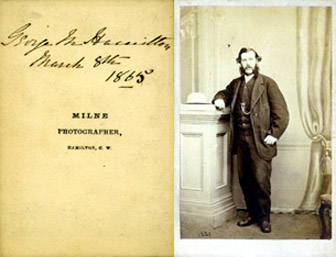THE HEART OF THE CITY
R. MILNE CO.
7 James Street North
Robert Milne was Hamilton’s first daguerrist,
an early form of photography using glass negatives. It is likely that he apprenticed for
this form of photography in Scotland, where he was born and raised. He moved to Hamilton
in 1851 and set up an office on James Street South above Osborne’s shop. Milne stayed
in Hamilton for a long time compared to many other photographers. It was the tendency of
this profession to drift from town to town.
 Portraits
at that time were quite expensive; they ranged in price from $1 to $25. Still,
Milne’s business did very well and by 1858, he moved his establishment to larger
quarters on the Northeast corner of King and James Street. He spent 11 years at this
location and has been called "Hamilton’s most important photographer."
Portraits
at that time were quite expensive; they ranged in price from $1 to $25. Still,
Milne’s business did very well and by 1858, he moved his establishment to larger
quarters on the Northeast corner of King and James Street. He spent 11 years at this
location and has been called "Hamilton’s most important photographer."
Robert Milne was the first ever in Canada to use
photography as an investigative tool in 1857, in the aftermath of the Desjardins
Canal Disaster. Milne was instrumental in aiding with the identification of the
unrecognized dead. He took photographs of the corpses so that the deceaseds'
remains might be identified by friends and family.
On May 24, 1860, Milne was asked to photograph the
dedication of Hamilton’s new waterworks. He also took early pictures of the Gore Park
fountain and photographed the laying of the cornerstone for Crystal Palace. In December
1855, he made plans to photograph the business section of Hamilton, providing local
businessmen with the best advertisement they could have. He charged $5 for a copy of his
project.  The Hamilton Spectator
and the Canadian Illustrated News often contained illustrations from Milne. Famous
Hamilton citizens such as Sir Allan Napier MacNab, Mayor Henry McKinstry, Isaac Buchanan, and John Gamble Geddes posed for portraits in his
studio. Geddes even wrote in his diary that he felt Milne’s photographs were better
than any he had seen taken in London, England. He felt that Milne was a gaining worldwide
reputation. Portraits taken of MacNab and Buchanan were enlarged to life-size using a
pantagraph. This instrument was capable of enlarging even the smallest daguerreotypes to
life-size. The prints would then be coloured with oils. According to Milne’s
advertisement, pantagraphs could produce "the most durable and correct portraits that
can be taken." MacNab and Buchanan’s portraits were printed on canvas nine feet
by six feet in size. He put these photographs in an exhibit at his James Street gallery,
as he did with many of his works.
The Hamilton Spectator
and the Canadian Illustrated News often contained illustrations from Milne. Famous
Hamilton citizens such as Sir Allan Napier MacNab, Mayor Henry McKinstry, Isaac Buchanan, and John Gamble Geddes posed for portraits in his
studio. Geddes even wrote in his diary that he felt Milne’s photographs were better
than any he had seen taken in London, England. He felt that Milne was a gaining worldwide
reputation. Portraits taken of MacNab and Buchanan were enlarged to life-size using a
pantagraph. This instrument was capable of enlarging even the smallest daguerreotypes to
life-size. The prints would then be coloured with oils. According to Milne’s
advertisement, pantagraphs could produce "the most durable and correct portraits that
can be taken." MacNab and Buchanan’s portraits were printed on canvas nine feet
by six feet in size. He put these photographs in an exhibit at his James Street gallery,
as he did with many of his works.
Due to increased competition and the high cost of
equipment, by the mid-1860’s Milne was no longer the dominant local artist. By 1870,
he was operating out of his home and ten years after that he had given up the trade.
Charles Cunningham took over Milne’s business and destroyed thousands of existing
plates, stereographs and records. Milne died on March 6, 1891 in the United States and was
buried in the Hamilton Cemetery.
REFERENCES:
Dictionary of Hamilton
Biography. Volume 2. W.L. Griffin Ltd. 1991.
Antiques by Jack Jamieson Scrapbook. Special Collections, HPL.
The Spectator Semi-Weekly. December 19, 1855. Special Collections, HPL.
The Spectator Semi-Weekly. August 20, 1856. Special Collections, HPL.
The Hamilton Spectator. August 30, 1860. Special Collections, HPL.

 Portraits
at that time were quite expensive; they ranged in price from $1 to $25. Still,
Milne’s business did very well and by 1858, he moved his establishment to larger
quarters on the Northeast corner of King and James Street. He spent 11 years at this
location and has been called "Hamilton’s most important photographer."
Portraits
at that time were quite expensive; they ranged in price from $1 to $25. Still,
Milne’s business did very well and by 1858, he moved his establishment to larger
quarters on the Northeast corner of King and James Street. He spent 11 years at this
location and has been called "Hamilton’s most important photographer." The Hamilton Spectator
and the Canadian Illustrated News often contained illustrations from Milne. Famous
Hamilton citizens such as Sir Allan Napier MacNab, Mayor Henry McKinstry,
The Hamilton Spectator
and the Canadian Illustrated News often contained illustrations from Milne. Famous
Hamilton citizens such as Sir Allan Napier MacNab, Mayor Henry McKinstry, 